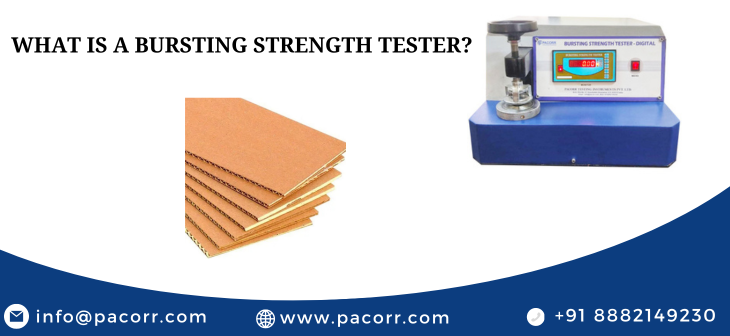
A bursting strength tester measures the pressure required to rupture a material, typically fabric, paper, or cardboard, by hydraulically loading it until it fails. A Bursting Strength Tester is a fundamental instrument used extensively across various industries to measure the strength of materials under pressure. Predominantly utilized in the packaging sector, especially for testing paper, cardboard, textiles, and synthetic leathers, this equipment provides critical data that help in assessing the durability and endurance of materials before they are shaped into final products. The testers offered by Pacorr are engineered to align with global testing standards such as ASTM D 3786-01, ASTM D 3786 – 80A, and ISO 1060 PART-1 1987, ensuring compliance with international quality benchmarks.
Understanding Bursting Strength and Its Importance
Bursting strength measures the force required to rupture a material sample under controlled conditions. This metric is crucial because it directly relates to the structural integrity and quality of materials. Manufacturers rely on bursting strength values to predict how materials like paper, textiles, or cardboard will behave under stress during shipping, handling, and everyday use.
Exploring the Standards: ASTM and ISO Guidelines
Two primary standards govern the testing protocols for bursting strength—ASTM and ISO. The ASTM D 3786 standards (both -01 and -80A) are specific to textiles, providing guidelines on how to conduct tests effectively, whereas ISO 1060 PART-1 1987 focuses on paper and board. These standards ensure that tests are repeatable and consistent across different laboratories and industries worldwide.
The Pacorr Bursting Strength Tester: Features and Benefits
Pacorr’s Bursting Strength Tester is designed with precision and user-friendliness in mind. Some of the standout features include:
- Digital Display: For accurate and easy reading of results.
- Automatic Testing Process: Reduces human error and increases repeatability.
- Robust Construction: Ensures durability and long-term use.
Using this equipment offers numerous benefits:
- Quality Assurance: Helps manufacturers ensure only the best quality products go to market.
- Cost Efficiency: Identifying material flaws early reduces waste and enhances production efficiency.
- Regulatory Compliance: Adherence to ASTM and ISO standards keeps businesses in line with international regulatory requirements.
Industries Utilizing Bursting Strength Testers
Various industries benefit from the use of bursting strength testers, including:
- Packaging: To ensure boxes and containers can withstand shipping stresses.
- Textile: For assessing fabric durability under stress.
- Paper Manufacturing: To guarantee the strength of paper products like bags and envelopes.
The Role of Bursting Strength in Product Development
In product development, knowing the bursting strength of materials helps engineers and designers create products that withstand expected loads and stresses. It’s a critical step in the R&D process, influencing material choice, product design, and ultimately consumer satisfaction.
Comparative Analysis: Bursting Strength Tester vs. Other Strength Testing Methods
While bursting strength testers focus on under-pressure scenarios, other strength testing methods, like tensile or compression testing, provide insights into different aspects of material behavior. A holistic view of material properties can be achieved by employing several testing methods in tandem.
Client Testimonials and Case Studies
Real-world applications and feedback from businesses that utilize Pacorr’s Bursting Strength Tester highlight its reliability and the tangible benefits it brings to operations.
Maintenance Tips for Longevity and Optimal Performance
Proper maintenance is key to ensuring the longevity and reliability of bursting strength testers. Regular calibration, careful handling, and adherence to operational guidelines are vital.
How to Choose the Right Bursting Strength Tester for Your Needs
Factors to consider include material type, testing frequency, industry standards, and specific features like digital or analog output.
Future Trends in Material Testing
Innovations in material testing, including automation and integration with IoT devices, are set to revolutionize how businesses evaluate material strength and quality.
Thanks to Pacorr Testing instruments, we have all the required quality testing instruments that have helped us to ensure the best quality delivered to our clients.

Danish
Fair Exports Pvt. Ltd.

